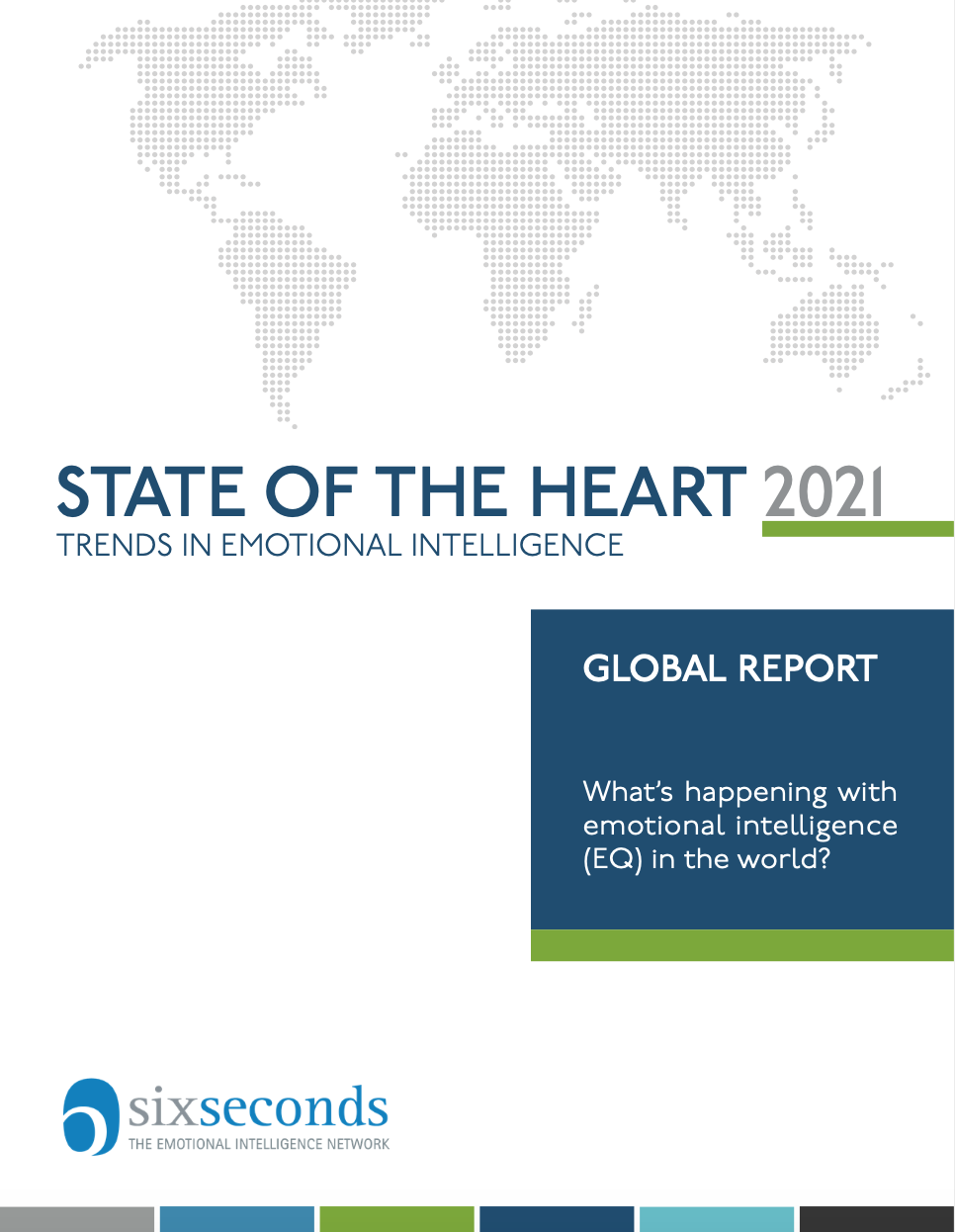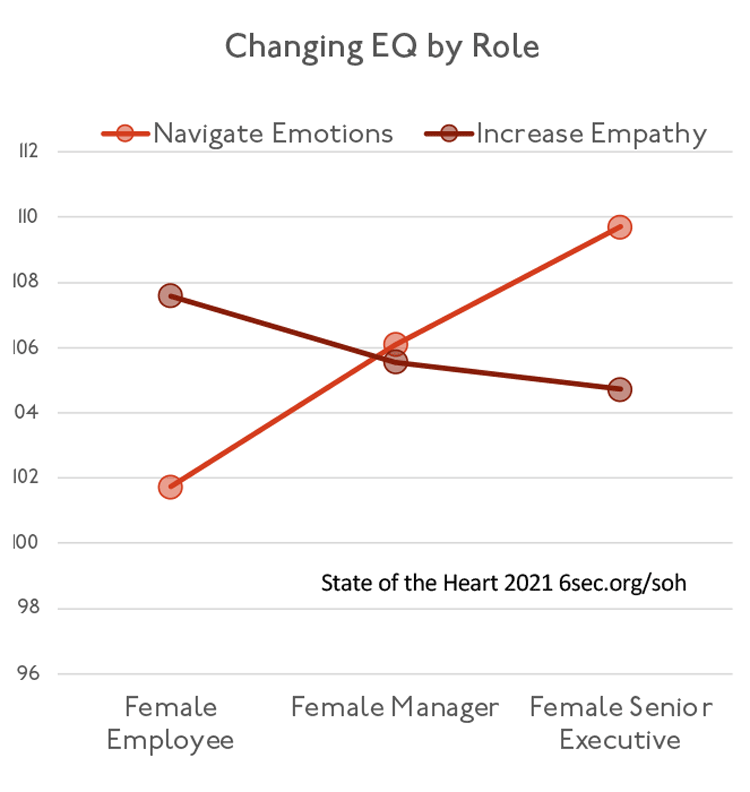Women
at Work:
3 Key Insights from
New Global Research
Women in the workplace faced added challenges during the pandemic. How did women fare as leaders? While men and women are equal for many leadership tasks, most often the emotional work of leadership falls to women – and this has some surprising outcomes.
Two major research studies combine to paint a compelling picture of women’s experience at work. Here are 3 key takeaways from McKinsey’s 2021Women in the Workplacereport – the largest study of women in corporate America – and Six Seconds’ 2021State of the Heartreport – the world’s largest study of emotional intelligence
byMichael Millerand Patty Freedman
1. Women leaders support their teams and promote employee wellbeing.
与男性相比在类似的职位,女性管理rs do significantly more to support employees. They check in more regularly, help manage workloads, and provide emotional and logistical support. Employees struggling to navigate complex work life challenges during the pandemic, or dealing with burnout, most often turn to their women leaders. The result?Employees report women supporting their careers at twice the rate of men.
Consider this: McKinsey’sWomen in the Workplacereport found that employees were equally likely to say that men or women senior leaders had supported them in their careers – even though men outnumbered women in the study 2 to 1 – indicating that an unsustainable burden of sponsorship or mentorship falls on women.
The data also reveals that most of this emotional leadership goes unrewarded and unrecognized, and can lead to overwhelmed leaders.

Where should we send your copy of the State of the Heart report?
Emotional Tradeoffs for Women Leaders
The emotional inequity explained in the McKinsey report links to a key finding in State of the Heart: While all other aspects of emotional intelligence are correlated with career advancement for women leader (see point 3),empathy declines.
The graph to the right shows Navigate Emotions (the ability to handle complexity and use emotions as resources) which is strongly correlated with advancement for women. At the same time, there’s a decline in Increase Empathy (the ability to connect with and appropriately respond to emotions). The same is not true for men.Why would this be?
One possible explanation is that the expectations of organizational culture push women leaders to suppress empathy and handle increased emotional complexity – perhaps internalizing the message that women should be more like men, while still doing more emotional leadership work. Perhaps these results come from a lack of role models for women in leadership.
In any case, this graph illustrates the emotional tradeoffs many women leaders are facing.In a context of gender inequity, advancement comes with an added cost – which may help explain why women leaders experience a higher level of burnout.
2. Women leaders experience higher levels of burnout.
What harmful effects have women leaders experienced in their home and work life as a result of the COVID-19 pandemic? Women are even more burned out than they were a year ago, likely due to the added stress and complexity of the pandemic. The burnout-gap between women and men has almost doubled. In the past year, 1 in 3 women has considered leaving the workforce or downshifting their careers — and 4 in 10 have considered leaving their company or switching jobs, perWomen in the Workplace.
The additional burdens women face that undermine their leadership and challenge their competence also contribute to burnout. Being interrupted, hearing comments on their emotional state, or having their judgment questioned are examples of emotional burdens women face more than men. This is likely to be a driving force in the decline in empathy reported above.These factors increase as women advance in leadership, and may be exacerbated in virtual workplace settings. In contrast, men do not face these challenges as frequently.
女性领导者能做什么呢to navigate this workplace reality and advance in their careers?
3. Emotional intelligence supports women leaders’ advancement.
Women continue to face a “broken rung” at the first step up to manager: for every 100 men promoted to manager, only 86 women are promoted (McKinsey). So how do women climb the career ladder? One oft-repeated explanation or story is that women simply ‘need to be more confident,’ and that will fix this gap; research suggests that’s bad advice:
Dr. Leonora Risse of RMIT University, says she heard this “confidence narrative” countless times early in her career: “You need to change the way you are going about things. Lean in, be courageous. You need to sign up for confidence training. They recommended a course literally called Shameless Self-Promotion.” Dr. Risse dug into the data to see if any evidence supported this obsession with women’s confidence. What she found, published in theAustralian Journal of Labour Economics, confirmed her sense that ‘be more like men’ is bad advice for women: Men who have high confidence are, statistically speaking, rewarded for it more often. Women are also rewarded for confidence, but only to a certain extent – well below the level at which men’s confidence is correlated with promotions and pay raises. In other words, theresearch shows “acting confident” has little benefit for women leaders’ career advancement -@leonora_risse
Whatdoessupport women’s career advancement? Six Seconds’ State of the Heart report shows emotional intelligence may be the key: Female managers score 6.1% higher on total emotional intelligence than do female employees, and senior executives score 8.7% higher – suggesting that emotional intelligence helps close the “broken rung” on the advancement ladder.
What comes next?
2020 and 2021 are disrupting workplaces around the globe. Will these massive changes catalyze larger shifts?Virtual and hybrid workplaces are creating new demands, and new emotional complexities. Will this shift stereotypes about leadership and push organizations to embrace a more empathic, human-centered leadership? The upheavals could exacerbate existing inequalities, or open the door to a new era of gender equity.

You may also like…
- Pursue Noble Goals in the Six Seconds Model of EQ- July 29, 2023
- Increase Empathy in the Six Seconds Model of EQ- July 26, 2023
- Exercise Optimism- July 24, 2023




I’m happy to have read this report for two reasons; firstly, it connects personally with the nature of my work which is having its up and down sides to deal with, and secondly it relates professionally as I’m working for a housekeeping company as a trainer and looking after ladies who are working as domestic workers in Dubai for different families.
Working in a household is not easy, and it’s terrible if you are not in good terms with the employer. The problem gets even worse when you are tied in the house for months before having an option for outdoor activities during the weekends during the lockdown caused by the pandemic.
Whether it’s a maid, nanny, babysitter or housekeeper, they often look at the weekend moments with friends to refresh and recharge their batteries, when the pandemic denied such a situation of relaxation, the stress and mental state will have its toll on those workers.
Being a trainer and leader for them, they often tend towards me to share their stories of sufferings or mental issues, and it was my duty to make them feel better considering all the bad moments they are through.
It’s obviously going to help me the content of this report and hope this will shed some light to many others life too.
Regards,
Anna
Maids Trainer at Housekeeping Co (https://www.housekeepingco.com)
Good reporting. Thanks!